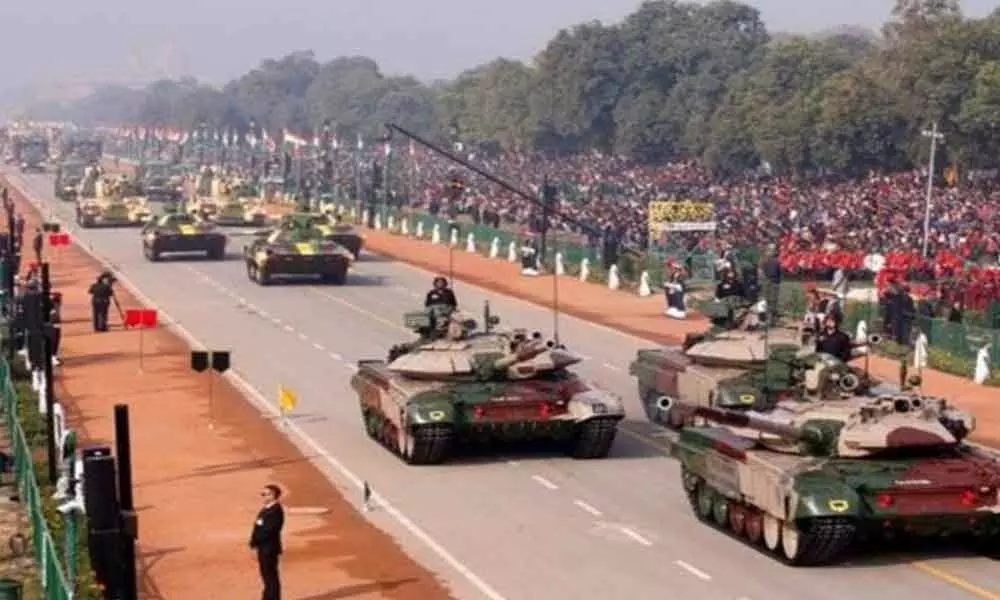Defence Budget 2022: What lies ahead of capability building exercise?
India’s threat levels have zoomed to a stiff graph. As China tests our resolve, Pakistan tests our patience. Under the circumstances will the defence budget presented enhance our capabilities for all eventualities?
image for illustrative purpose

Defence Minister Rajnath Singh says funding does not come in the way of the country's defence preparedness and there will be no compromise on it. We have taken precautions that there is no shortcoming on the country's defence preparedness in any way by means of budget constraints. Through enhanced budgetary support over the years, the Government has placed modernisation and infrastructure development of the Armed Forces at the centre stage of the National Security and Defence Planning process, he said.
In 2019-20, one-third (32.19 per cent) of the total capital expenditure of the central government is being spent on defence which is the highest among all other central ministries. Earmarked 64.09 per cent of the total Capital Acquisition Budget for 2021-22 for domestic capital procurement and 15 per cent of capital procurement budget for direct procurement from private industry, he adds further.
Praising this year's budgetary outlay, the Minister tweeted that the "Union Budget 2022-23 would give further fillip to 'Make in India', boost demand and build capacities for a stronger, prosperous and confident India. The total allocation under Capital Outlay of the Defence Services has been increased from Rs 86,740 crore in 2013-14 to 1.52 lakh crore in 2022-23. There is an enhancement of 76 per cent over a period of nine years".
A closure scrutiny of the budgetary outlay in terms of being a capability building instrument - the Defence Minister is using a common figure of rhetoric. Although the year-on-year growth of around 10 per cent in the defence budget for the financial year 2022-23 (FY23) is better than the corresponding growth of 1.45 per cent in the preceding year, but its share in the total central government expenditure has slid from 13.73 per cent to 13.31per cent. As a percentage of the Gross Domestic Product (GDP) also, it has dropped from 2.15 per cent to 2.04 per cent, much to the demand of defence budget at 3 per cent of the GDP.
India's defence budget has been hovering around this level for quite some time. Consequently, there has been little change in the public discourse which remains centred on the inadequacy of resource allocation for defence and the possible ways of addressing this problem. It isn't any different this year.
The outlay for the three-armed Services – Army, Air Force and Navy, forms the core of the defence budget. Out of the total defence budget of Rs. 5.25 lakh crore, the Services have been allocated Rs 3.85 lakh crore and Rs 1.52 lakh crore for capital expenditure and Rs 2.33 lakh crore for revenue expenditure- during the Financial Year (FY) 2022-23.
The allocated amount of Rs 3.85 lakh crore falls short of the requirement projected by the Services. The gap has been widening for serval years, jumping from approximately Rs 23,000 crore in 2010-11 to more than Rs 1,25 lakh crore in the FY22, of which Rs 77,182 crore was under the capital segment of the budget. If the estimates projected by the Services to the 15th Finance Commission are any indication, the shortfall in the FY23 could be in the region of Rs 2.81 lakh crore, with the shortfall under the capital segment accounting for a little less than Rs 1.62 crore. The budgetery allocation could not possibly have bridged this gap in the Union Budget.
The paucity of funds and resource crunch is glaring. It was also widely expected that Union Budget would announce the setting up of a non-lapsable Defence Modernisation Fund from which additional sums could be allocated for meeting the expenditure on modernisation of the armed forces if required during the year. Recommended by the 15th Finance Commission, virtually at the behest of the government, this fund has been in the works for almost a year but it was not done.
It is pertinent to mention that to encourage domestic industry, the capital procurement budget has been enhanced by 10 per cent to 68 per cent in FY23 up from 58 per cent in FY22. It is not known how much of this will go towards meeting committed liabilities arising from the ongoing contracts and what amount will be available for new purchases. While this may be music to the ears of the Indian industry, it sends some confusing signals to the foreign vendors, besides being of little help in dealing with the chronic paucity of funds.
To conclude, while FY23's defence budget is slightly better than the FY22 in terms of the growth in the outlay, it is likely to fall short of the requirement projected by the Services, which has been the main problem for decades. Consequently, the modernisation drive is unlikely to gather faster pace during the coming fiscal. The capabilities of the Indian military have not kept pace with the unprecedented threats posed by Pakistan and China.
(Author is a journalist who writes on defence, strategic affairs, security and conflict)

